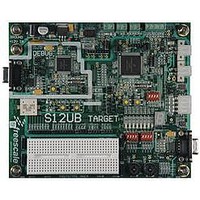LFEBS12UB Freescale Semiconductor, LFEBS12UB Datasheet - Page 714

LFEBS12UB
Manufacturer Part Number
LFEBS12UB
Description
KIT STUDENT LEARNING S12 DG128
Manufacturer
Freescale Semiconductor
Specifications of LFEBS12UB
Architecture
8/16-bit
Code Gen Tools Included
Code Warrior
Silicon Manufacturer
Freescale
Core Architecture
S12
Core Sub-architecture
S12
Silicon Core Number
MC9S12
Silicon Family Name
S12D
Kit Contents
HCS12 DG128 Learning Kit
Rohs Compliant
Yes
Lead Free Status / RoHS Status
Lead free / RoHS Compliant
- Current page: 714 of 1328
- Download datasheet (9Mb)
Chapter 19 Pulse-Width Modulator (S12PWM8B8CV1)
8-bit counter is re-loaded. The output signal from this circuit is further divided by two. This gives a greater
range with only a slight reduction in granularity. Clock SA equals clock A divided by two times the value
in the PWMSCLA register.
Similarly, clock B is used as an input to an 8-bit down counter followed by a divide by two producing clock
SB. Thus, clock SB equals clock B divided by two times the value in the PWMSCLB register.
As an example, consider the case in which the user writes $FF into the PWMSCLA register. Clock A for
this case will be E divided by 4. A pulse will occur at a rate of once every 255x4 E cycles. Passing this
through the divide by two circuit produces a clock signal at an E divided by 2040 rate. Similarly, a value
of $01 in the PWMSCLA register when clock A is E divided by 4 will produce a clock at an E divided by
8 rate.
Otherwise, when changing rates the counter would have to count down to $01 before counting at the proper
rate. Forcing the associated counter to re-load the scale register value every time PWMSCLA or
PWMSCLB is written prevents this.
19.4.1.3
Each PWM channel has the capability of selecting one of two clocks. For channels 0, 1, 4, and 5 the clock
choices are clock A or clock SA. For channels 2, 3, 6, and 7 the choices are clock B or clock SB. The clock
selection is done with the PCLKx control bits in the PWMCLK register.
19.4.2
The main part of the PWM module are the actual timers. Each of the timer channels has a counter, a period
register and a duty register (each are 8-bit). The waveform output period is controlled by a match between
the period register and the value in the counter. The duty is controlled by a match between the duty register
714
Writing to PWMSCLA or PWMSCLB causes the associated 8-bit down counter to be re-loaded.
Because of an order from the United States International Trade Commission, BGA-packaged product lines and partnumbers
indicated here currently are not available from Freescale for import or sale in the United States prior to September 2010
PWM Channel Timers
Clock Select
Clock SA = Clock A / (2 * PWMSCLA)
When PWMSCLA = $00, PWMSCLA value is considered a full scale value
of 256. Clock A is thus divided by 512.
Clock SB = Clock B / (2 * PWMSCLB)
When PWMSCLB = $00, PWMSCLB value is considered a full scale value
of 256. Clock B is thus divided by 512.
Writing to the scale registers while channels are operating can cause
irregularities in the PWM outputs.
Changing clock control bits while channels are operating can cause
irregularities in the PWM outputs.
MC9S12XE-Family Reference Manual , Rev. 1.23
NOTE
NOTE
NOTE
NOTE
Freescale Semiconductor
Related parts for LFEBS12UB
Image
Part Number
Description
Manufacturer
Datasheet
Request
R
Part Number:
Description:
Manufacturer:
Freescale Semiconductor, Inc
Datasheet:
Part Number:
Description:
Manufacturer:
Freescale Semiconductor, Inc
Datasheet:
Part Number:
Description:
Manufacturer:
Freescale Semiconductor, Inc
Datasheet:
Part Number:
Description:
Manufacturer:
Freescale Semiconductor, Inc
Datasheet:
Part Number:
Description:
Manufacturer:
Freescale Semiconductor, Inc
Datasheet:
Part Number:
Description:
Manufacturer:
Freescale Semiconductor, Inc
Datasheet:
Part Number:
Description:
Manufacturer:
Freescale Semiconductor, Inc
Datasheet:
Part Number:
Description:
Manufacturer:
Freescale Semiconductor, Inc
Datasheet:
Part Number:
Description:
Manufacturer:
Freescale Semiconductor, Inc
Datasheet:
Part Number:
Description:
Manufacturer:
Freescale Semiconductor, Inc
Datasheet:
Part Number:
Description:
Manufacturer:
Freescale Semiconductor, Inc
Datasheet:
Part Number:
Description:
Manufacturer:
Freescale Semiconductor, Inc
Datasheet:
Part Number:
Description:
Manufacturer:
Freescale Semiconductor, Inc
Datasheet:
Part Number:
Description:
Manufacturer:
Freescale Semiconductor, Inc
Datasheet:
Part Number:
Description:
Manufacturer:
Freescale Semiconductor, Inc
Datasheet:










